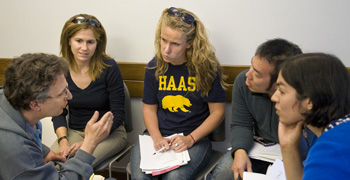Tech Transfer: UC Students to Evaluate Market Potential of Lab Technologies By Julie Chao, Creative Services Office
 Michael Mueller, with Tech Transfer, discusses Ashok Gadgil’s (EETD) low-cost water purification technology with students
Michael Mueller, with Tech Transfer, discusses Ashok Gadgil’s (EETD) low-cost water purification technology with students
Berkeley Lab may be bursting with clean technologies to address the global energy problem, but it isn’t always clear how best to get those technologies out of the lab and into the marketplace. The Technology Transfer Department has lacked the sheer manpower to do the deeper market research and analysis sometimes necessary for commercialization. Enter an eternally renewable—and free—resource: grad students.
In the first program at this scale at the Lab, UC Berkeley grad students will evaluate technologies and strategies developed at the Lab, assess their commercial viability, and conduct a market analysis. If signs look good, the hope is that a business plan could eventually emerge from the so-called Cleantech to Market (C2M) program, which is a partnership with the Berkeley Energy and Resources Collaborative (BERC), a student-led campus group.
Robin Johnston of Tech Transfer says the department had been recruiting students with the hope of forming two or three teams of about five students each. Much to their surprise, they received 65 applications for 15 slots. “We were blown away,” says Johnston. “We decided to take the plunge and expand from three teams to eight. There’s obviously a lot of energy out there for this sort of thing.”
The largest portion of the 40 students are getting MBAs, and the rest represent a broad spectrum of fields, including law, public policy, natural resources, public health, chemistry, and other science and engineering fields. They have been assembled into eight multidisciplinary groups, each assigned a patent-pending technology (such as a novel solar-chemical storage device and a low-cost water purification method) or a policy area (such as new ways to deploy energy efficient building technologies) to evaluate with guidance from a Lab researcher.
The program is now getting started with orientation sessions where student meet their research sponsors, get an overview of the tech transfer and patenting processes, and sign confidentiality agreements. After 10 weeks, each group will give a presentation at a VIP reception that will include people from the business and venture capital communities.
"We were somewhat unprepared for the tremendous response from bright, energetic students,” says Ashok Gadgil, a senior scientist of the Environmental Energy Technologies Division and research sponsor of two of the C2M groups. “For me it is exciting to see this level of interest—and the student CVs that I have seen are stellar!”
For students, C2M is an opportunity to not only learn about cleantech but also get some firsthand experience in what it takes to bring a technology to market. “As a grad student, we dwell very much in academia; we’re working on fundamental science that hopefully will be used to solve something,” says Alison Hardin, a C2M participant and a doctorate student in chemistry. “This gives students a glimpse at how something will translate to the real world.”
For one student from Germany, Philipp Sandner, who is a visiting scholar in economics, the opportunity is especially exciting because “these are the technologies that might change the world in 10 or 20 years.” Plus, he adds, such a program could not be found in German universities. “If you try to engage with scientists in Germany, they don’t want to know anything about business,” he says. “They just want to do their science. We don’t have big technology transfer.”
The students have their work cut out for them. They will be looking at issues such as revenue potential, intellectual property, market size (domestic versus international), and promising licensing models. “We market 40 to 50 technologies a year,” Johnston told students at an orientation session. “We simply don’t have time to drill down and find out what the market’s really like and always find maybe those 10 companies in the sweet spot. We’re looking forward to having you guys do some of that for us and give us some more market intelligence on the technologies.”
Even more overwhelming than the student interest was the response to the program from corporations and venture capital firms, who are especially hungry for cleantech investment opportunities. AT&T has agreed to give $4,000 to the program, PG&E will give $2,000, and other corporate donations are anticipated. The sponsorships are basically no-strings-attached.
